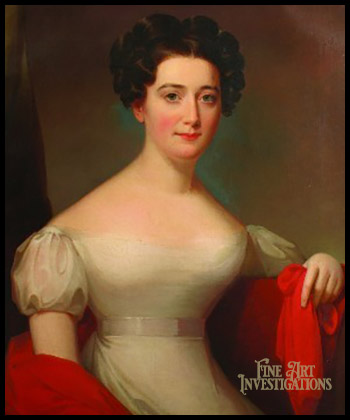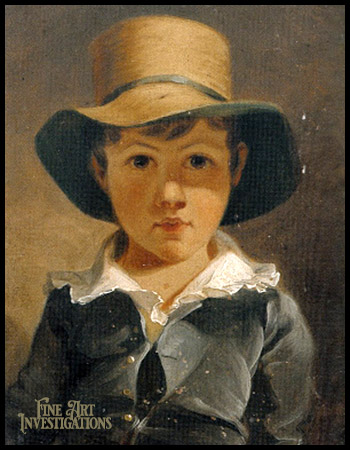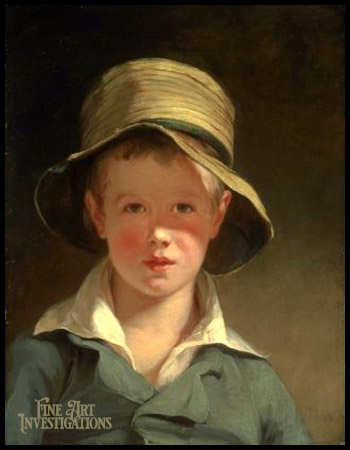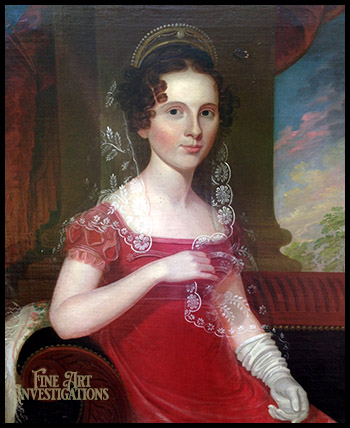Jacob Eichholtz
American Artist 1776-1842
Pennsylvania artist Jacob Eichholtz has too long been hidden under the shadow of his famous friend Thomas Sully (1783-1872). In nearly every region, the memory of one artist clouds remembrance of other competent, and sometimes masterful, artists. In Missouri, the artistic giant is George Caleb Bingham; in Pennsylvania, it is Thomas Sully.
Sully, from a theatrical family, painted with dramatic flair. Eichholtz’s style reflected the careful, responsible hardworking man he was and had to be. Art was always his passion, but especially in the early years of the republic, an unpractical profession, so he apprenticed with his uncle, a coppersmith. In April 1803, when he was 26, the young tradesman married a 32-year-old widow with two children, Catharine. By December, they had a child of their own, Caroline, She survived only nine months, but three more children followed:, Catherine Marie (1806-1848), Rubens Mayer (1810-1841), and Margaret Amelia (1814-1882). Jacob recorded his sales and their prices in account books. He knew when he could comfortably create his early profile paintings, such as Miss Shaum, 1808/1810, gentle, honest in the best sense of American folk art. Yet, he labored over techniques he learned from Sully in 1808 and from Gilbert Stuart in 1812, until the quality of his work surprised even his mentors. How much Eichholtz advanced his technique in only a few short years is exemplified in his 1815 painting of his five-year-old son, Rubens, a charming and harmonious work. Sully stole the concept half a decade later, brightened the light, added more red to the palette, lowered the subject on the canvas, and changed the focus from symmetrical to asymmetrical to create the timeless, iconic Torn Hat. The model was his own son, nine-year-old son, Thomas Wilcocks Sully (1811-1847).

Jacob Eichholtz
Elizabeth A. Brooke Weed (Mrs. Robert J. Arundel, ca. 1828
Canvas, 30 x 25 inches Private Collection

Jacob Eichholtz
Rubens Mayer Eichholtz (Torn Hat), 1815
Private Collection

Thomas Sully
The Torn Hat,1820
Museum of Fine Arts Boston,16.104

Jacob Eichholtz
Julia Anna Marion Prosser (Mrs. Richard Bland Lee II) (1805-1886) ca. 1825
Canvas 30 x 25 inches Private Collection
Eichholz’s wife died in 1817. He waited the obligatory year and then wed 26-year-old Catharine Trissler (1791-1867). Of the nine children she bore all but one thrived, Edward (1819-1821) Those who lived to adulthood were:Anna Maria (1820–1882), Elizabeth Susanna (1823–1842), Benjamin West (1824–1897), Angelica Kaufman (1826–1916), Rebecca Trissler (1828–1888), Henry Clay (1830-1913), Robert Lindsay (1833–1912), and Lavallyn Barry (1835–1849). Eichholtz could fully support his ever-increasing family with a brush instead of a hammer by 1820. He moved to Philadelphia where among the many portraits he painted, two forgotten artworks came to Fine Art Investigations for artist identification: Julia Anna Marie Prosser (Mrs. Richard Bland Lee II) (1805-1886), ca. 1826, and Elizabeth A. Brooke Weed (Mrs. Robert J. Arundel), (1810-1892) ca. 1828. The pastel window view in the former made it one of Eichholz’s more interesting portraits. if it had remained relegated by New York galleries to Artist of the American School. If the latter painting if had remained relegated by New York galleries as Artist of the American School. the portrait would probably have fetched two-thirds less than its respectable hammer price.
About 1831, Eichholtz and his family returned to Lancaster. He continued to paint portraits and even progressed to history paintings, such as Mark Antony Delivering his Oration over the Body of Caesar. He died in Lancaster on May 11, 1842 at the age of 65.
Over the years, Jacob Eichholtz diligently compensated for his late start and initial lack of training. In the mid-1830s, he portrayed a former Secretary of State and future president, James Buchanan (1791-1868), in a painting that hangs at the Smithsonian American Art Museum.
Sources:
Beal, Rebecca J., Jacob Eichholtz 1776-1842: Portrait Painter of Pennsylvania, Philadelphia, The Historical Society of Pennsylvania, 1969
Gerdts, William H., Art Across America, Two Centuries of Regional Painting: The East and the Mid-Atlantic, Abbeville Press Publishers, 1990, 268
Groce, George C. and David H. Wallace. The New York Historical Society’s Dictionary of Artists in America. Yale University Press. 1957.
Ryan, Thomas Robert, ed., The Worlds of Jacob Eichholtz, Lancaster County Historical Society, 2003.
Smithsonian Institution Research and Scholars Center, Smithsonian American Art Museum, “Jacob Eichholtz,” Art Inventory Catalog Inventory of American Painting, Smithsonian Institution Research Information System SIRIS, http://siris-artinventories.si.edu/ipac20/ipac.jsp?session=SI0120N352621.2680&menu=search&aspect=Keyword&npp=50&ipp=20&spp=20&profile=ariall&ri=1&source=~%21siartinventories&index=.AW&term=Jacob+eichholtz&x=0&y=0&aspect=Keyword, accessed Spring, 2014.
